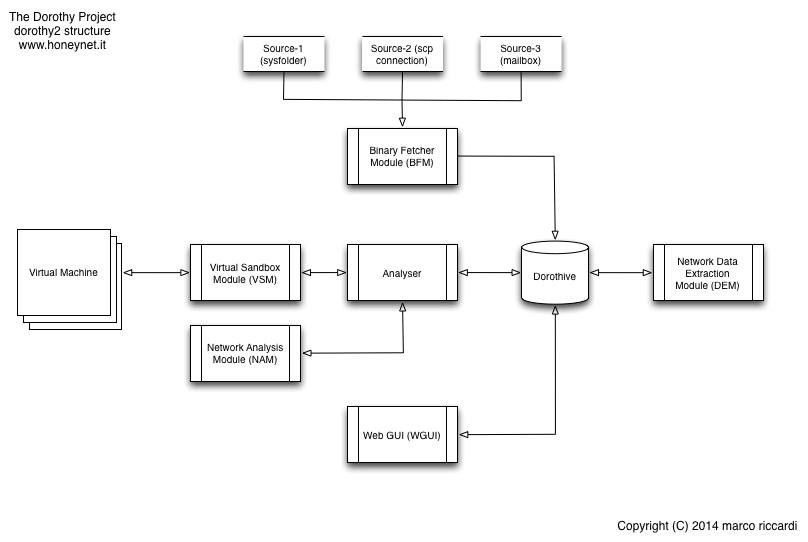dorothy2: A malware/botnet analysis framework

Dorothy2
A malware/botnet analysis framework written in Ruby.
Dorothy2 is a framework created for suspicious binary analysis. Its main strengths are a very flexible modular environment and an interactive investigation framework with a particular care of the network analysis. Additionally, it is able to recognize newly spawned processes by comparing them with a previously created baseline. Static binary analysis and an improved system behavior analysis will be shortly introduced in the next versions. Dorothy2 analyses binaries by the use of pre-configured analysis profiles. An analysis profile is composed of the following elements:
- A certain sandbox OS type
- A certain sandbox OS version
- A certain sandbox OS language
- A fixed analysis timeout (how long to wait before reverting the VM)
- The number of screenshots requested (and the delay between them)
- A list of the supported extensions, and how the guest OS should execute them
The use of profiles gives the researcher the possibility to run analysis on a set of binaries by using different environments. As it is known, some malwares are configured to run only in the specific environment. A CSIRT might use them to test suspicious malwares only against an environment that reflects one of its customers. Sources can also be configured to be automatically analyzed by certain profiles (e.g. use Profile_Windows_30sc for all the binaries retrieved by Kippo_source).
Dorothy2 is a continuation of my Bachelor degree’s final project (Dorothy: inside the Storm ) that I presented in Feb 2009. More information about the whole project can be found on the Italian Honey project website.
The framework is mainly composed of five modules that can be even executed separately. The following picture gives an overview of the current modules and how they are connected each other.
- The Binary Fetcher Module (BFM)
In charge of retrieving the binaries from the configured sources. Currently a “binary source” can be system folder, an email-box, or a host reachable by ssh. Once the binaries have been retrieved, the BFM will populate the analysis queue.
- The Dorothy analysis engine
In charge of analyzing the queue by executing the scheduled binaries into a sandbox, and then storing the generated network traffic and its screenshots into the analysis folder (moreover populating Dorothive with the basic information of the file, and CouchDB with the network pcaps).
- The (network) Data Extraction Module (old dparser)
In charge of dissecting the pcaps file, and storing the most relevant information (flows data, GeoIP info, etc) into Dorothive. In addition, it extracts all the files downloaded from the sandbox through HTTP/HTTPS and stores them into the binary file’s analysis folder.
- The (dummy) Webgui
A dummy Sinatra application which gives an interactive overview of all the acquired data. WARNING: this module is intended to be executed in a controlled environment. The author strongly discourages to expose it on the Internet.
- The Java Dorothy Drone (Mainly coded by Patrizia Martemucci and Domenico Chiarito, but not part of this gem and not publicly available.)
Installation
Usage
Copyright (C) 2015 m4rco-
Source: https://github.com/m4rco-/






